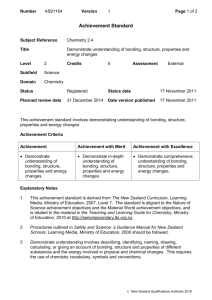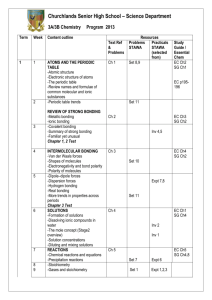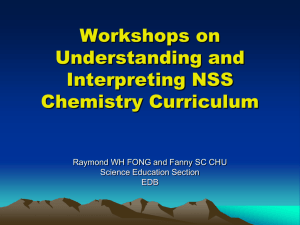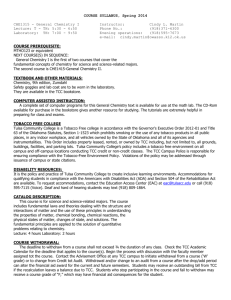SS1 Chem Introductio..
advertisement
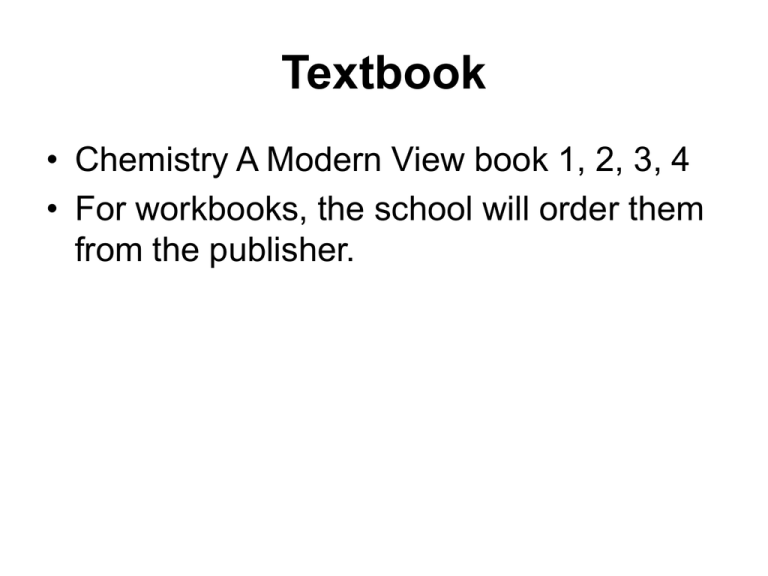
Textbook • Chemistry A Modern View book 1, 2, 3, 4 • For workbooks, the school will order them from the publisher. Types of work • • • • • HW Book - long questions Classwork Book – M.C. + long questions Experiments in workbooks Investigative study with Lab report Reading comprehension Internal Assessment • 30% term marks (25% test + 5% class performance) • 70% exam marks. • If late in handing in HW for 3 times, 1 mark will be deducted from the class performance. SS1 Syllabus -1st term • • • • • • • • • • • • • • • • • • • Ionic and Covalent Bonding Rocks and minerals Structure and bonding in metals Structure, bonding and properties Formula masses and relative molecular masses Reactivity of Metals Uses of Common Metals Corrosion of metals Reacting masses Acids and Alkalis Indicators and pH Strength of acids and alkalis Neutralization and salts Concentration of solutions Simple Volumetric Work Covalent & Dative covalent bonding Shapes of covalent molecules Intermolecular forces Hydrogen bonds and van der Waal’s Forces SS1 Syllabus -2nd term • • • • • • • • • • • • Chemical cells in daily life Simple Chemical Cells Redox Reactions Cell Reactions Electrolysis Energy changes in chemical reactions, standard enthalpy changes Hess‘s Law Rate of reaction Molar volume Equilibrium law Fossil Fuels Homologous series Revision Techniques • Why should you revise? • ‘cos you cannot remember all the Chemistry that you have studied unless you revise. • Where should you revise? • A quiet room • How should you revise? • Plan your break before the start of your revision. • more efficient and feel less tired • How often should you revise? • Remember: the most important point about revision is that it must occur often and be repeated at the right intervals. • No pain!!! No gain!!!!!!!!!!!!!!!!!!!!! Hong Kong Diploma of Secondary Education Chemistry NSS Chemistry Public Assessment Papers Sections Section A (18%) Paper 1 (2.5 hours) Section B (42%) Parts Topics Questions Part I Topics 1-8 24 M.C. Part II Topics 1-12* 12 M.C. Topics 1-8 structured Qs (47 marks) essay (9 marks) Part I Part II Paper 2 (1 hour) 20% SBA 20% Total 100% Topics 1-12* Topics 1315# structured Qs (28 marks) structured Qs 20 marks per elective (40 marks) • * Emphasis would be put on Topics 9-12 • # May include contents of Topics 1-12 Chemistry-Paper 2 (Electives) • One question is set for each of the three electives, candidates are required to answer any 2 out of them. Chemistry-Paper 2 (Electives) • Industrial Chemistry • Materials Chemistry • Analytical Chemistry Standards Referenced Reporting (SRR) • • • • • • The standards are held constant The percentage of students awarded a given level may vary from year to year The standards are more informative Level descriptors together with exemplars can better reflect the standards Standards setting • Based on examination results, candidates are awarded with a total score • To determine the minimum scores (also known as cut scores) a candidate must obtain for meeting various standards (Levels 1-5) U 1 2 3 4 5 School-based Assessment (SBA) SBA TASKS Weighting 20% of Public Assessment Mode Non Practical Related Practical Related Task type Basic Chemical Analysis Experiment Investigative Study Assignment Task code BCA EXPT IS ASSN SBA requirements Number of assessments on SBA tasks BCA EXPT IS ≥1 ≥3 1 ASSN SS6 SS5 SS4 ≥1 Number of Experiments (including BCA & EXPT, but excluding IS) SS6 SS5 SS4 ≥8







